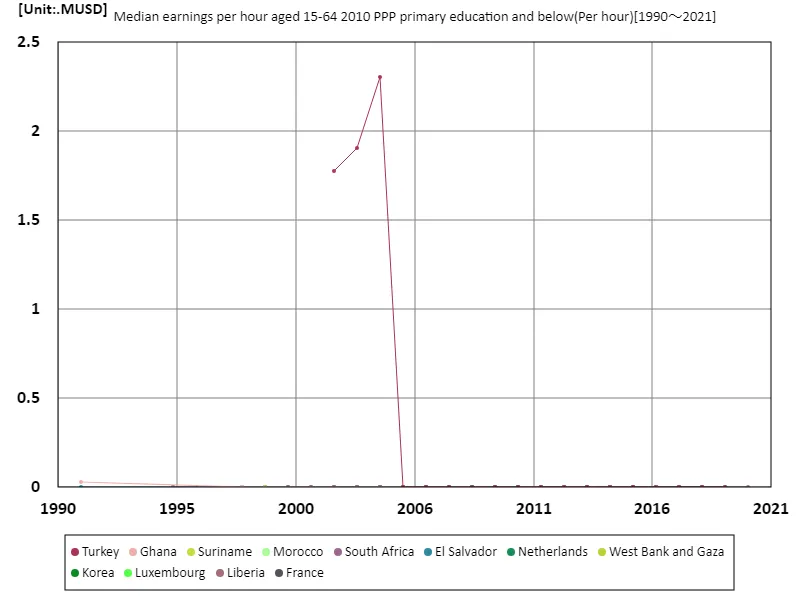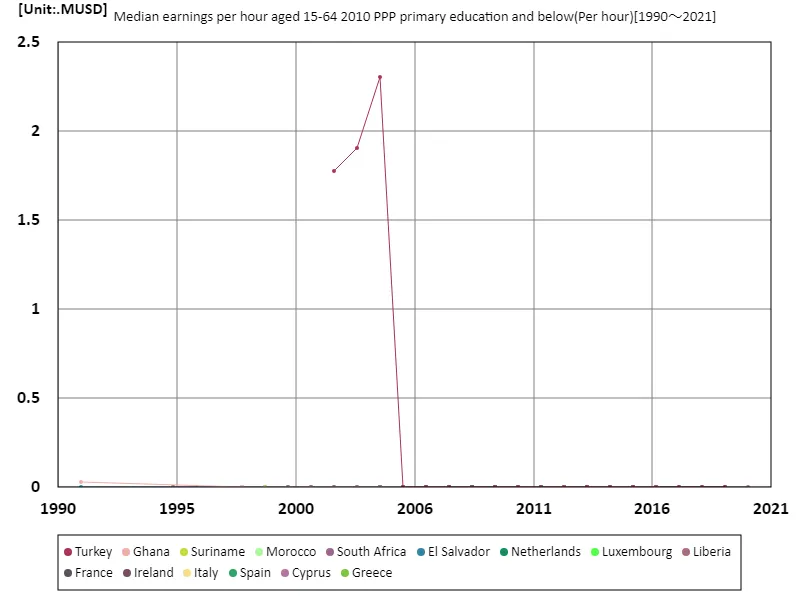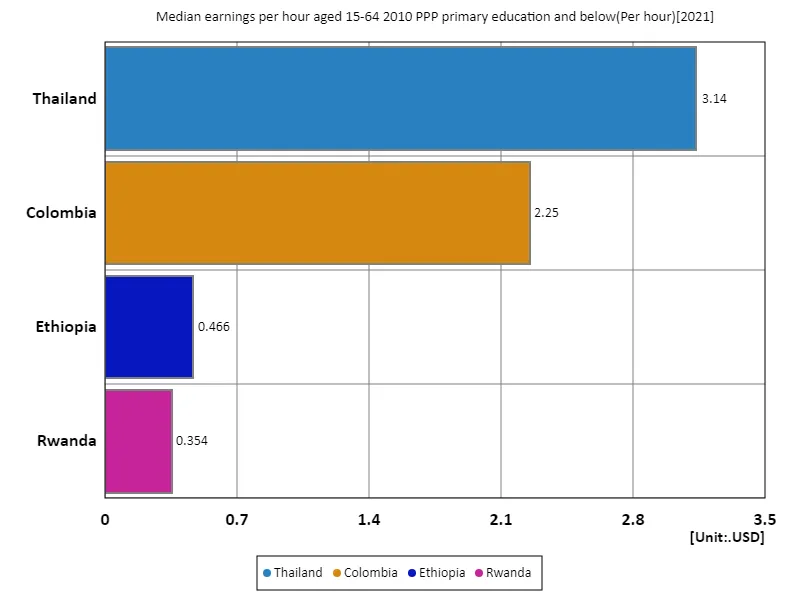- Abstract
- Average hourly wage (primary education or below, 15-64 years old, 2010 purchasing power parity)
- Average hourly wage (primary education or below, 15-64 years old, 2010 purchasing power parity) (worldwide)
- Average hourly wage (primary education or below, 15-64 years old, 2010 purchasing power parity) (worldwide, latest year)
- Reference
Abstract
Data on global employment and wages reflect economic development, education levels and the structure of the labour market. Wages vary widely across countries, especially when focusing on workers with primary school education or less. According to 2020 data, South Africa has the highest average hourly wage at $2.37, which is likely due to the country’s unique economic environment and labor supply and demand balance. In general, workers with lower levels of education tend to be less able to benefit from technological innovation and economic growth. However, there are cases, such as South Africa, where wages have risen as a result of the development of certain industries. In contrast, wages in developing countries tend to be stagnant due to lack of educational opportunities and highly competitive labor markets. Internationally, wage disparities are widening, while cases of stagnant wages for workers are on the rise even in developed countries. This is due to the impacts of globalization and automation, as well as increased competition from low-wage countries. The improvement of education policies and social security systems will be important factors in determining future wage trends.
Average hourly wage (primary education or below, 15-64 years old, 2010 purchasing power parity)
Average hourly wage data from 1991 to 2020 (primary education or less, ages 15-64, 2010 purchasing power parity) shows the changes in each country’s economic situation and labor market. In particular, the average hourly wage of 2.3 MUD recorded by Turkey in 2004 reflected the economic growth at the time, while the subsequent 167% decline is likely due to a variety of economic factors. In Turkey, wage levels fluctuate due to economic policies and external factors (e.g. political instability and inflation). In general, the wages of less educated workers are more vulnerable to competition and technological change in the global economy, and wages in developing countries tend to stagnate. In contrast, in countries with growing economies, wages tend to rise as the balance between supply and demand of workers improves. Additionally, globally, as inequality widens, competition from low-wage countries is affecting workers, and there are increasing cases of wage stagnation, especially in developed countries. Given this situation, improving education and skills will be key to future wage growth.


The maximum is 2.3MUSD[2004] of Turkey, and the current value is about 167μ%
Average hourly wage (primary education or below, 15-64 years old, 2010 purchasing power parity) (worldwide)
Average hourly wage data from 1991 to 2020 (primary education or less, ages 15-64, 2010 purchasing power parity) reflects changes in economic conditions and labour markets across countries. In particular, Turkey’s average hourly wage of 2.3 MUD recorded in 2004 indicates economic growth at the time, but has now fallen to 167% of its peak. The decline can be attributed to political instability and economic fluctuations in Türkiye. During this period, there has been an overall trend of wage inequality widening, with the wages of workers with primary school education or below being particularly affected by globalization and technological innovation. In many developing countries, a lack of educational opportunities leads to stagnant wages, while in growing economies there is greater potential for wage growth. Even in developed countries, competition from low-wage countries is affecting wages and causing workers’ incomes to stagnate. These trends have increased the importance of education and skills development, and improving education policies and social security is key to increasing the competitiveness of workers. While wage levels are expected to rise in the future, it will be necessary to pay close attention to economic fluctuations.


The maximum is 2.3MUSD[2004] of Turkey, and the current value is about 167μ%
Average hourly wage (primary education or below, 15-64 years old, 2010 purchasing power parity) (worldwide, latest year)
The 2021 average hourly wage data (primary education or below, 15-64 years old, 2010 purchasing power parity) reflects the current state of the global employment market. The value of 3.14 USD recorded by Thailand indicates the development of the local economy and growth of certain industries. On the other hand, the overall average of 1.55 USD and the total of 6.21 USD suggests that there is a large disparity in worker wages. The data shows that wages for workers with primary school education or less vary from country to country, with the level of education and the degree of economic development having a direct impact on wages. In particular, wages tend to rise in countries experiencing rapid economic growth, but conversely, in developing countries, wages often remain low due to a lack of educational opportunities. Furthermore, as globalization progresses worldwide, competition from low-wage countries is intensifying and wage growth is stagnating even in developed countries. In these circumstances, education and skill development are becoming increasingly important, and policies to increase the competitiveness of workers are needed. In the future, improving the quality of education may contribute to higher wages, but flexibility in responding to economic fluctuations will also be essential.


The maximum is 3.14USD of Thailand, the average is 1.55USD, and the total is 6.21USD



Comments